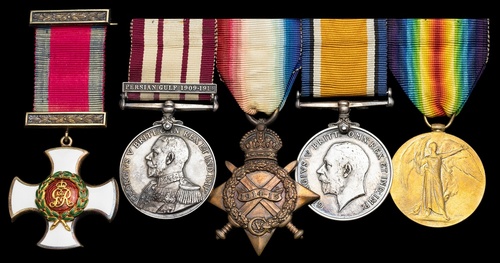
Auction: 25001 - Orders, Decorations and Medals
Lot: 307
The 'Dardanelles and Bulgarian Coast Minesweeping 1918' D.S.O. group of five awarded to Commander H. de G. Lamotte, Royal Navy in command of H.M.S. Craigie
He served on the former torpedo gunboat H.M.S Seagull earlier in the war on minesweeping duties
Distinguished Service Order, G.V.R., with integral top ribbon bar; Naval General Service 1915-62, 1 clasp, Persian Gulf 1909-1914 (Lieut. H. De. G. Lamotte. R.N. H.M.S. Prosperine); 1914-15 Star (Lt. Commr. H. De G. Lamotte. R.N.); British War and Victory Medals (Lt. Commr. H. De G. Lamotte. R.N.), very fine (5)
D.S.O. London Gazette 17 October 1919, the original recommendation states:
'H.M.S. Craigie. Displayed great skill and coolness in handling the twin screw sweepers under his orders. The conditions were difficult and at times hazardous and it is largely owing to the magnificent work done by the twin screw sweepers that a channel through the Dardanelles has been cleared of mines.'
Harold de Gallye Lamotte was born at Kingston on Thames on 2 December 1882, the son of barrister William de Gallye Lamotte. He joined H.M.S. Brittania as a Midshipman on 15 January 1900 and was appointed Sub. Lieutenant 15 January 1903. Given his first command appointment on 14 July 1904 Lamotte joined H.M.T.B. 45, a first-class torpedo boat, and was subsequently advanced to Lieutenant on15 January 1905.
His next appointment was aboard Prosperine from July 1910 until August 1912 chasing gun runners in the Merran coast and qualifying for his Naval General Service Medal. On 15 January 1913 he was advanced to Lieutenant-Commander.
Seagull and Muskerry
After a period of training, Lamotte was given his next command appointment of H.M.S. Seagull, a former torpedo gunboat which had been converted to a minesweeper on 17 December 1914.
Seagull joined the newly established Grand Fleet. The old torpedo gunboats such as Seagull were not well suited to continual use in the rough waters around Scapa Flow, and in July 1915 Seagull and sister ship Spanker were deployed to Harwich to sweep ahead of the Harwich Force when it went to sea.
On 15 February 1917 Seagull was east of Aldeburgh when a periscope, probably of the German submarine UC-1, was spotted. Seagull dropped two depth charges on the wake of the periscope. He left Seagull on 22 May 1917 to command Muskerry from June 1917 until March 1918.
Craigie
Lamotte was given command of Craigie on 26 July 1918. A Hunt-class minesweeper she was launched on 29 May 1918 and from November 1918 was based in the Adriatic arriving in Mudros on 24 May 1919 before sailing for Kephalo for further minesweeping duties. Lamotte remained aboard her until 23 November 1919 and was rewarded the D.S.O.
He retired from the service at his own request on 29 September 1920 and was invested with his D.S.O. at Buckingham Place on 12 October 1920. Promoted to the rank of Commander (retired) on 2 December 1922, Lamotte was honoured with the Freedom of the City of London in 1927.
Lamotte died on 3 June 1960 at a nursing home in Morden; sold together with copied research.
Subject to 20% VAT on Buyer’s Premium. For more information please view Terms and Conditions for Buyers.
Estimate
£1,200 to £1,600
Starting price
£950




